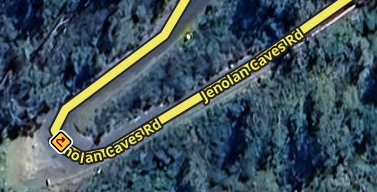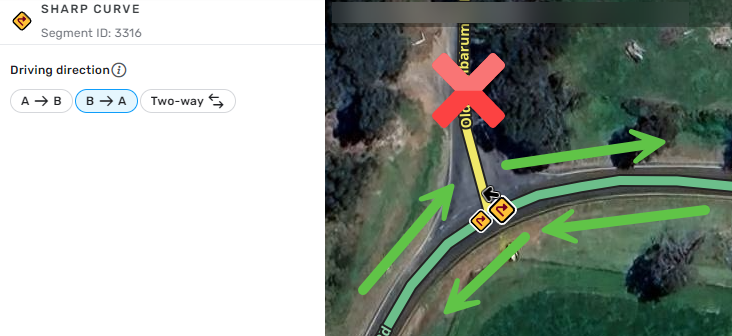LostInMyMaps (talk | contribs) (Added additional images) |
LostInMyMaps (talk | contribs) (More images) |
||
| Line 19: | Line 19: | ||
== Alerts in the Waze Application == | == Alerts in the Waze Application == | ||
[[File:Aus-PH-Alerter02.png|thumb|350x350px|An example of how permanent hazards appear in the Waze app.]] | |||
To receive a permanent hazard alert, the driver must be using the Waze application with a destination set. Permanent hazard notifications will appear 500m before the hazard. | To receive a permanent hazard alert, the driver must be using the Waze application with a destination set. Permanent hazard notifications will appear 500m before the hazard. | ||
Revision as of 06:20, 22 February 2024
| This page is in draft and will change. Do not start mapping permanent hazards in Australia using it. |
| This page has entered a review period for feedback. Please use the #wiki-chat channel on the Waze Australia Discord server to discuss this draft with your peers and leaders, and share your feedback with the community. |
| Typos or errors? Please contact LostInMyMaps directly. |
This wiki page explains the guidelines for mapping permanent hazards in Australia, a feature allowing map editors to map hazards that are constantly present and pose an ongoing risk to drivers.
In Feb 2024, Waze launched a new top menu item in WME called Hazard. While cameras and railway crossings are now under this menu item, they will not share the capabilities/rules with Permanent Hazards.
Locking
Feature and country-specific lock levels, including for this feature, are documented in country specific permissions. Where a segment is locked higher than the feature lock, any permanent hazards attached will also be automatically locked to the segment level.
Permanent Hazards

Waze is primarily used by drivers who routinely drive the same route daily, such as to work and home. These drivers are often already aware of permanent hazards on their routine drives and there is little benefit in providing added safety alerts to these drivers. Providing unnecessary alerts can lead to alert fatigue and cause drivers to disengage from the alerts or turn them off. Australian road infrastructure is also generally well-engineered and modern, and hazardous road features are rare. For these reasons, Waze Australia has adopted a conservative approach to map permanent hazards only in empirically hazardous conditions, as documented below, and in the most extreme circumstances. When drivers hear a permanent hazard alert in Australia, they can trust the alert requires their attention and that changes to driving behaviour are needed for safety reasons. It is for this reason that not every hazard should be mapped in Australia, and hazards that do not follow these guidelines may be deleted.
Permanent hazards mapped in Waze Australia should meet objective standards to be mapped, as guided by state road authorities, wherever possible. Just because you subjectively feel a hazard applies does not mean it can be mapped in Waze Australia.
In Australia, permanent hazards should only be mapped on public roads, i.e. narrow passageway, street, primary street, minor/major highway, motorway or ramp. Never map permanent hazards in private locations, such as industrial areas, car parking or private estates like caravan parks.
Alerts in the Waze Application

To receive a permanent hazard alert, the driver must be using the Waze application with a destination set. Permanent hazard notifications will appear 500m before the hazard.
To help avoid alert fatigue, the Waze application will:
- Group the same type of hazards together if they’re 500m of each other and only alert the first hazard
- A "familiarity cap" applies after encountering the hazard twice, snoozing the alert for 21 days afterwards
- Alerts in Waze are prioritised, which may delay or suppress the alert if higher priority alerts are activated.
Hazard types
Sharp curve
Sharp curves are expected to be mapped exclusively as per the general restrictions listed under “Permanent Hazards” above, and in the following circumstances.
Before mapping a sharp curve, please accurately align the segment as per the guidelines at road alignment and angles.
Hairpin turns/bends
Hairpins are identified by their:
- Use to ascend or descend steep topography;
- Involve approximately a 180 degree change of direction or greater in a short distance;
- Are usually a single lane each direction; or
- Require significantly reduced speed to handle the turn safely.
Place the sharp curve hazard at the apex of the hairpin turn like so, to provide 500m notice to drivers in each direction.

Advisory signage
Where there is a difference of 50km/hr or more between a yellow, orange or red speed advisory sign and the road speed limit (speed in red circle on white background or a variable speed limit sign). Ignore school or variable time based speed limits in calculations.
E.g. The speed limit is 100km/hr, and an advisory speed for a curve is 40km/hr; the speed difference is 50km/hr or greater and, therefore, should be mapped as a sharp curve.


Red reduce speed sign
Alternatively, where there are no reduced speed limit or advisory speed signs ahead of a sharp curve, however, a red reduce speed sign is used directly ahead of the curve to reduce driver speed, and a sharp curve may be mapped.

Apex Intersection
Where there is an intersection at the apex of a sharp curve, map two sharp curves and set to one-way, as not to alert for drivers entering from the non-hazardous direction:

Pedestrian crossings
For the purposes of mapping, pedestrian crossings are large rectangular painted lines crossing the width of a road to form a path for pedestrians to walk. Signage and other line markings used to indicate a pedestrian crossing are not considered when mapping.
Pedestrian crossing hazards are expected to be mapped exclusively as per the general restrictions listed under “Permanent Hazards” above, and in the following circumstances:
- The pedestrian crossing is not controlled by traffic signals or lights (pelican crossings); AND
- The pedestrian crossing is operational 24 hours a day; AND
- The pedestrian crossing itself is not raised or elevated - if so, see speed bump; AND
- The speed limit is 50km/hr or higher. Ignore school or variable time based speed limits.
- Note: Where the speed limit is missing from the segment, the correct speed should be added. If the limit can not be ascertained don’t add until it can be.
Note: Where there is a speed bump immediately before the pedestrian crossing and the conditions for mapping a speed bump are met, map a speed bump instead.
Speed bump
A speed bump is expected to be mapped exclusively as per the general restrictions listed under “Permanent Hazards” above, and in the following circumstances.
Speed bump
A speed bump suitable for mapping is identified as:
- A speed bump / hump and sharp dip intended for the purpose of speed reduction;
- Cattle or stock grids in regional and remote Australia;
- Combination pedestrian crossings that are also a raised speed bump / hump, that may or may not be painted red (always map these as speed bumps);
- Cover the entire or partial width of the road or lane
- The speed limit is 50km/hr or higher. Ignore school or variable time based speed limits.
- Note: Where the speed limit is missing from the segment, the correct speed should be added. If the limit can not be ascertained don’t add until it can be.
xxImagexx
xxImagexx
Raised intersections
A raised intersection suitable for mapping is identified as:
- The centre of the intersection is raised creating a speed bump effect at each entry to the intersection;
- May or may not have pedestrian crossings entering the raised intersection (always map these as speed bumps).
- The speed limit is 50km/hr or higher. Ignore school or variable time based speed limits.
- Note: Where the speed limit is missing from the segment, the correct speed should be added. If the limit can not be ascertained don’t add until it can be.
Zone with an entry speed bump
A shared traffic zone or similar, with entry speed bump suitable for mapping is identified as:
- A sign posted “Shared Zone” or similar with slow speed limits; AND
- There is a speed bump or raised road at the entry boundary of the zone, give or take 10 metres of the boundary; AND
- The speed preceding is 50km/hr or higher. Ignore school or variable time based speed limits.
- Note: Where the speed limit is missing from the segment, the correct speed should be added. If the limit can not be ascertained don’t add until it can be.
Note: Subsequent speed bumps where the speed limit is less than 50km/hr should not be mapped, including the zone exit/final speed bump.
Speed bump exceptions
A speed bump should never be mapped where the road guttering continues across the intersection to form a dip:
xxImagexx
Where there are multiple speed bumps within a distance of 1 metre from the other, only a single speed bump should be mapped.
Note that “big and destructive speed bumps” or topes are not used in Australia.
Other hazards
Toll booths are disabled in Australia due to our exclusive use of nationwide electronic tolling. Other hazards, such as complex intersections and multiple lanes merging, are under consideration and review at the time of writing.